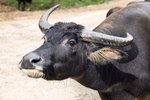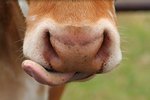In 2012, a Limousin bull named Fabio set the world record at auction, selling for 126,000 pounds or approximately $195,000. Limousins, native to France and now found all over the world, retain the hardy characteristics of their ancestors. The former owner of record-setting Fabio described him as docile, another characteristic of the Limousin breed. A typical Limousin produces more of the higher-end meat cuts than comparable breeds.
Appearance
The purebred Limousin boasts a coat of reddish gold. A Limousin bull weighs as much as 2,645 pounds. On average, he stands about 57 inches tall at the shoulder. The Limousin cow is smaller, averaging 1,540 pounds and 53 inches at the shoulder. While the breed was approximately the same height at the turn of the 20th century, the average weight has increased considerably due to changes and improvements in livestock management and feeding.
Hardiness
The history of Limousin cattle "might be as old as the European continent itself," according to the North American Limousin Foundation. Pictures drawn by early man in the Lascaux caves look like these cattle. The breed's native Limousin, a region just southwest of the center of France, isn't the most hospitable climate or terrain. Rocky soil there didn't allow for much in the way of agricultural production, so livestock needed to be tough to survive on the relatively sparse vegetation. Unlike traditional French cattle-keepers, Limousin owners didn't confine their stock but allowed herds to roam outdoors. This resulted in a tough, sturdy, healthy type of cattle, able to thrive on lesser quality forage. Because Limousin was relatively isolated, the cattle had little outside genetic influence, according to the NALF. It has managed to survive for, possibly, thousands of years. Although the breed is ancient, the first official herd book establishing Limousin uniformity was created in 1886.
Work and Meat
Today, the Limousin is considered a prime meat breed. In the days of working cattle, when oxen, or castrated males, supplied the power for carts and plows, the Limousin were renowned for their abilities. They did double duty. When they could no longer work, they were slaughtered for meat and leather. Limousin bulls sired these oxen workers, and also ended up as meat and leather at the end of their days.
Temperament
Limousin breeders have actively bred for temperament along with meat production, creating a docile breed of bull. The North American Limousin Foundation began deliberately encouraging breeding for a docile disposition and culling of bulls with difficult temperaments in the 1990s. Breeders score their bulls on a scale of 1 to 6 for temperament, with 1 as the calmest and 6 as quite aggressive. The breed association strives for bulls scoring 1s, described thus: "mild disposition, gentle, easily handled, stands and moves slowly during processing, undisturbed, settled, somewhat dull, does not pull on the headgate when in the chute, exits the chute calmly."
Fabio
Officially known as Dolcorsllwyn Fabio, the record-setting Limousin bull doesn't have to worry about ending up as dinner. That won't be true of most of his offspring, however. One reason Fabio fetched such as high price at auction is because his genes pass on extremely high growth rates. According to Whinfellpark Limousins, which markets Fabio's valuable semen, his genes produce calves in the top 1 percent for 200- and 400-day growth. Fast growth and high-quality meat is all a cattle breeder could want in bull sperm, hence Fabio's fetching price.
References
- Oklahoma State University: Limousin
- North American Limousin Foundation: The History of Limousin
- North American Limousin Foundation: Limousin Breeders Tackle Temperament
- Daily Mail: He’s Fabio! Prize Bull Smashes World Record as he Sells for £126,000 at Auction
- Cattle Network: Limousin
- Whinfellpark Limousins: Dolcorsllwyn Fabio Limousin Bull
Writer Bio
Jane Meggitt has been a writer for more than 20 years. In addition to reporting for a major newspaper chain, she has been published in "Horse News," "Suburban Classic," "Hoof Beats," "Equine Journal" and other publications. She has a Bachelor of Arts in English from New York University and an Associate of Arts from the American Academy of Dramatics Arts, New York City.




